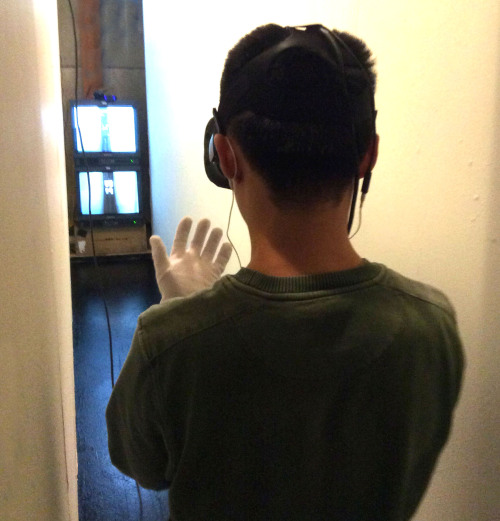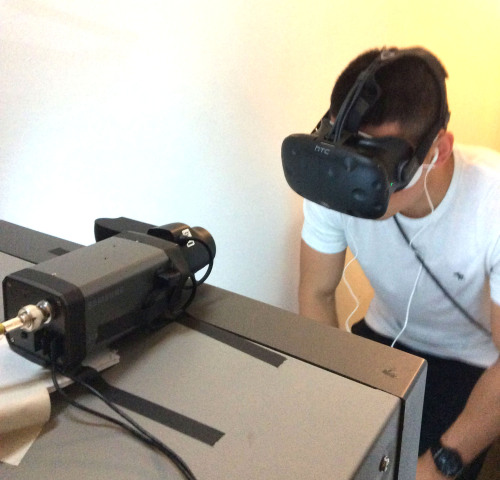
My installation “Live-VR Corridor (after Bruce Nauman)” made its world debut at the 9th New Media Film Festival in Los Angeles where it received the festival’s award for Best Mixed Reality!
“The overall result is an unsettling self-conscious experience of doubling and displacement.”
- Ted Mann on Bruce Nauman’s Live-Taped Video Corridor (1970)
Although its multiple histories are easily forgotten or ignored, the current generation of Virtual Reality art belongs to a tradition that includes experiments with perception and embodiment in film, video and installation art. Recalling parts of this history, Steve Anderson’s Live-VR Corridor consists of a ½ scale replica of Bruce Nauman’s Live-Taped Video Corridor (1970), one of the earliest works of video installation art. Live-VR Corridor is both a mixed reality homage to Nauman and a highly pleasurable, self-reflexive work of art in its own right. Just as the rise of amateur video in the 1970s spawned multiple experiments with liveness, surveillance and self-representation, today’s consumer VR offers a unique visual format that reactivates the pleasures and problematics found in looking, seeing and being seen.
Nauman’s original Live-Taped Video Corridor consisted of two closed-circuit video monitors positioned at the end of a narrow 30’ corridor. The lower monitor featured a pre-recorded videotape of the empty corridor, while the upper monitor showed a live video feed from a camera positioned above the corridor entrance. As viewers walked toward the monitors, they saw themselves from behind on the top monitor and a persistently empty corridor on the bottom monitor. The closer a viewer got to the monitor, the smaller their image became, frustrating their desire to see themselves, while the empty corridor on the bottom suggested that they had become invisible or dislocated in time.

When wearing the headmounted display (HMD), Live-VR Corridor viewers perceive a digital model that precisely duplicates the physical corridor they are in. Like Nauman’s original, the top monitor displays an image of viewers that shrinks procedurally as they approach it, frustrating their desire to see what they look like wearing the HMD. Unlike Nauman’s project, the bottom image displays a live feed from the forward-facing camera built in to the HMD. Thus, viewers who hold their hands in front of their face will see them on the monitor at the end of the corridor. As viewers move forward, their hands and other body parts grow more useful for orienting themselves spatially, but to do this, viewers must give up a traditional sense of embodied presence, shifting their viewing perspective to the monitor at the end of the corridor.

As the project unfolds, a voice queries the viewer’s sense of space, vision and embodiment. The project rewards slowness and contemplation, tracking the viewer’s gaze to reward exploration and curiosity by procedurally transforming the surfaces of the corridor in unexpected ways. An impatient viewer who rushes to see their image in the monitor will find that it shrinks to just a few pixels in size, while a calm viewer who takes time to experience the textures and sounds of the corridor can coax the scaled image to grow back to full-size, revealing what they look like wearing the HMD. Even at full size, the mirror image in the monitor continues to disorient the viewer by multiplying, reversing and displacing the viewpoint of the images in physical and virtual space.

Although perceptually complex, Live-VR Corridor is technologically simple, using two analogue surveillance cameras and 15” reference monitors for the images that appear in the physical corridor. The 15’ long walls are lightweight theatrical flats made with ¼” plywood that may be assembled or disassembled in a matter of hours. Two soft lights provide basic illumination. The physical corridor’s virtual double was created in Unity for display using an off-the-shelf HTC Vive system with two position trackers mounted at opposite ends of the corridor. The top (virtual) monitor shows a webcam video feed that is dynamically scaled in response to a viewer’s movements down the corridor. The bottom (virtual) monitor shows a direct video feed from the camera built in to the Vive headset, which captures analogue video images displayed on the monitors in physical space. No controllers or special calibrations are needed. The total footprint for the installation is 16’ x 2’. Average user experience is 3:00 minutes.
Watch video at: https://vimeo.com/230192895
Password: Anderson